I have a confession to make — I kill wheels and tires. Not because I like to. It just happens. I see a rowdy rock garden or a big feature, get too excited, and charge in with reckless abandon. Then I wake up on the side of the trail, dazed, thinking, “Oh no, it’s happened again.” A slashed tire lies beside me, bleeding sealant. The ride is ruined.
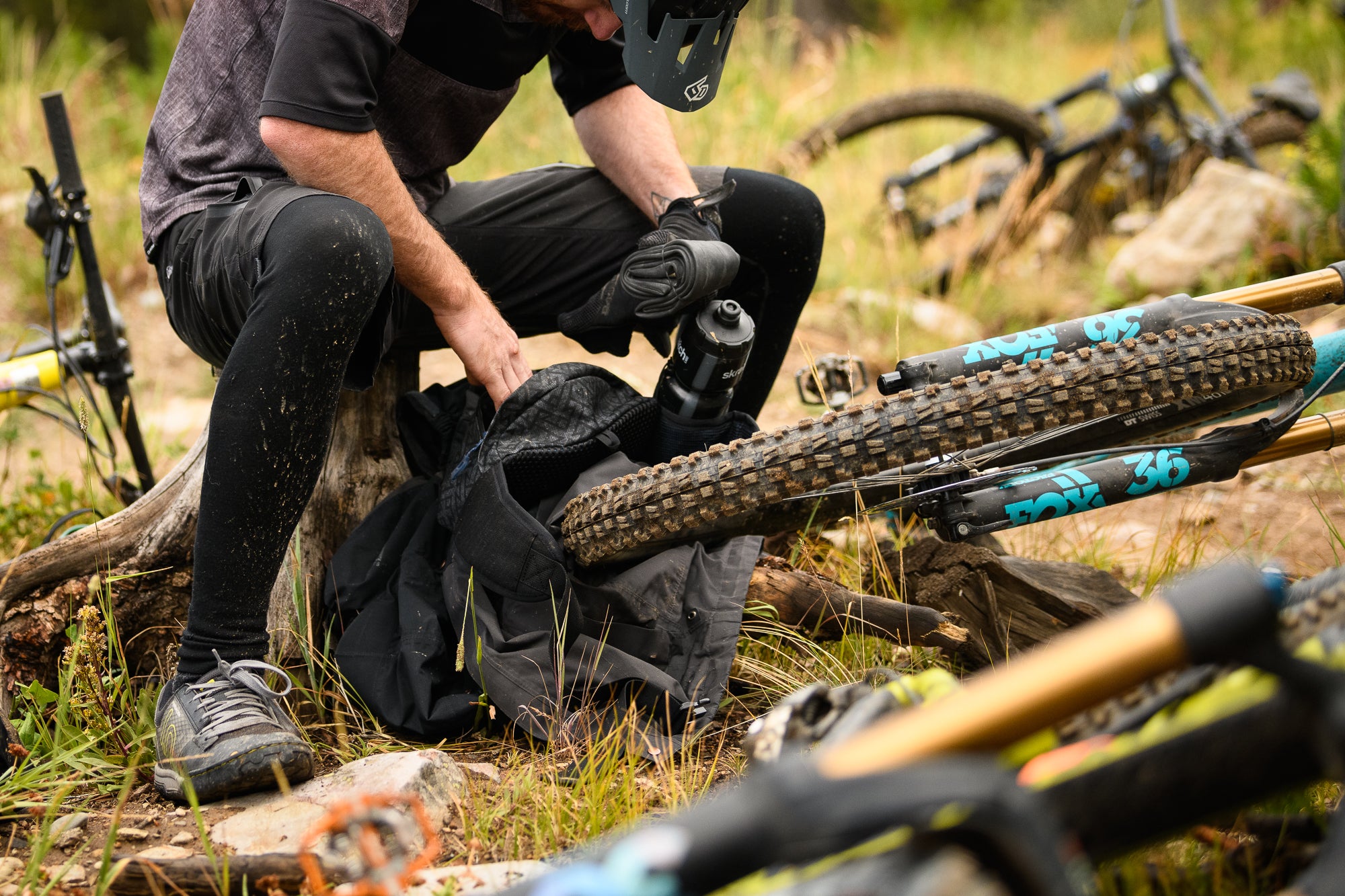 A flat tire from a rim strike can bring a good ride to a halt.
A flat tire from a rim strike can bring a good ride to a halt.For many riders who like to go fast on rough trails, flat tires and damaged rims are an annoying and common part of mountain biking. But in the last couple of years, foam tire inserts have emerged as a preventative solution. Tire insert brands like CushCore, Huck Norris, Vittoria Air-Liner, Flat Tire Defender, and Rimpact now give riders a wide range of options.
Inserts have become increasingly popular among downhill and enduro riders, and this summer, most of the enduro racers in our shop are running inserts in their own bikes. But do you need inserts? Let’s take a closer look at what tire inserts are, how they work, the pros and cons, and why some of our riders use them. That way, you can decide if inserts are worth adding to your bike.
Do you ride with inserts? Tell us about it in the comments at the end of this article.
What is a tire insert?
The story of the tire insert begins with the tire mousse. A mousse (French for “foam”) is a solid foam inner tube that originated in the world of off-road motorcycling to eliminate flat tires by replacing pressurized air. It never caught on in mountain biking. A solid foam tube is significantly heavier than air and the added rotational weight would make pedaling harder. Also, tire pressure is critical to how your bike feels and performs. A mousse can only provide one “pressure.” If conditions require a higher or lower psi, you’re stuck with what the mousse gives you. Any air-filled set-up — tubes or tubeless — is easier to tune and adjust to achieve the desired tire feel.
A mountain bike tire insert essentially splits the difference between a full mousse and a full tubeless set-up. CushCore, for example, is a foam tire insert that sits against the rim and fills approximately half of the tire. The rest of the tire is filled with air. The tire is seated just like a standard tubeless tire. The remaining air chamber allows pressures to be adjusted to suit rider preferences. This saves weight and allows for tire pressure adjustment. 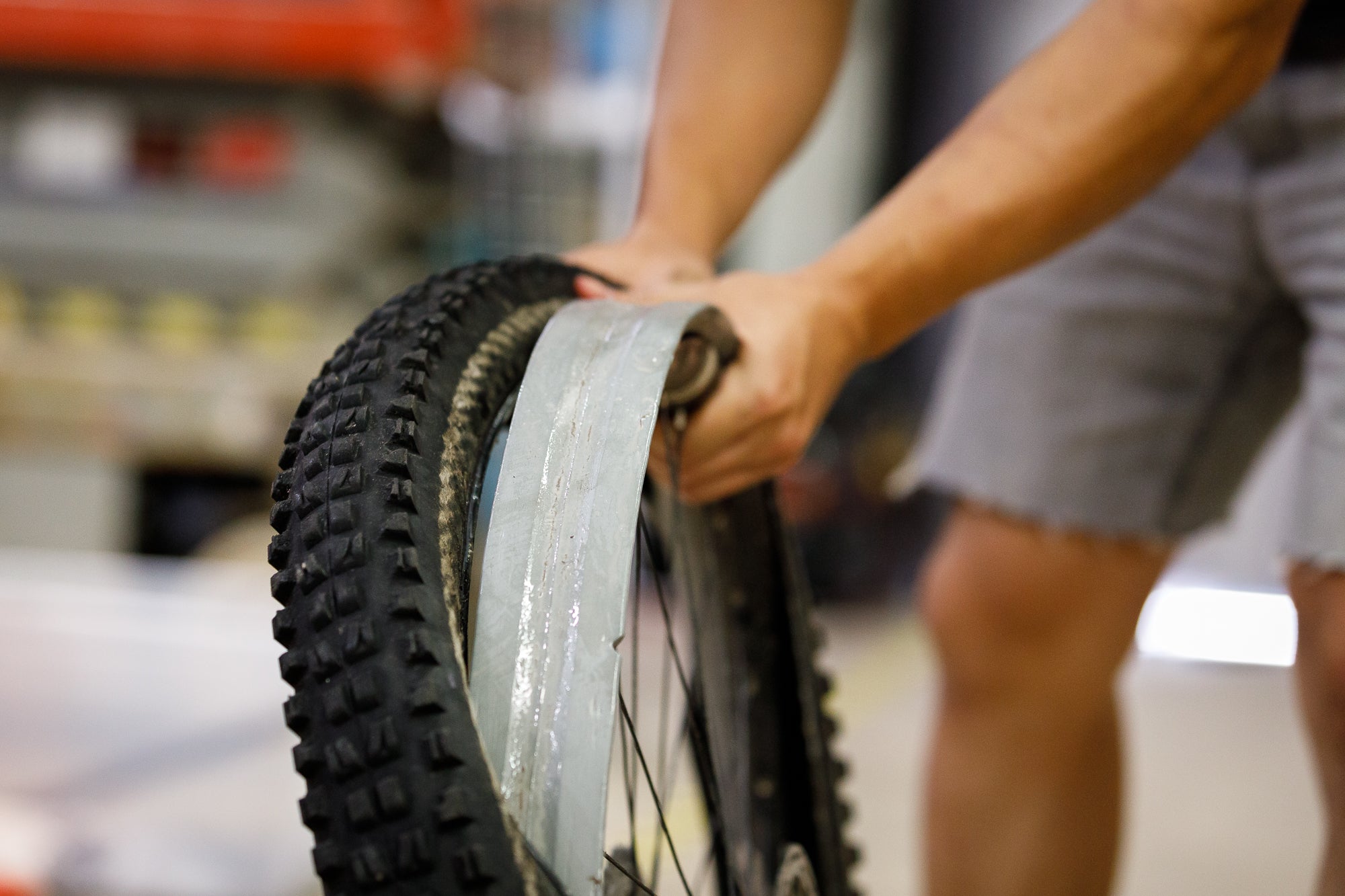
Skeptics have criticized tire inserts for looking similar to pool noodles or other foam household products. The difference, however, is that tire inserts are generally made from closed-cell foam. This foam is denser, more durable, and more impact-resistant. Most insert manufacturers select or develop specific types of foam to achieve specific ride characteristics. Closed-cell foam also resists absorbing fluids, preventing tire sealant from soaking into the insert.
How tire inserts work
Inserts have become more popular as modern riders and racers have pushed their equipment harder, descending faster on tougher terrain. On a mountain bike, damage to a tubeless (or tubed) rim or tire is often caused by extreme forces generated from smashing into an obstacle in the trail. Without an insert, the air in the tire compresses and the tire bottoms out against the rim. This impact can cut the tire, causing it to flat (often referred to as a ‘pinch flat’ or ‘snakebite’). The rim might get dented or cracked. This damage will be costly, especially for high-end carbon rims.
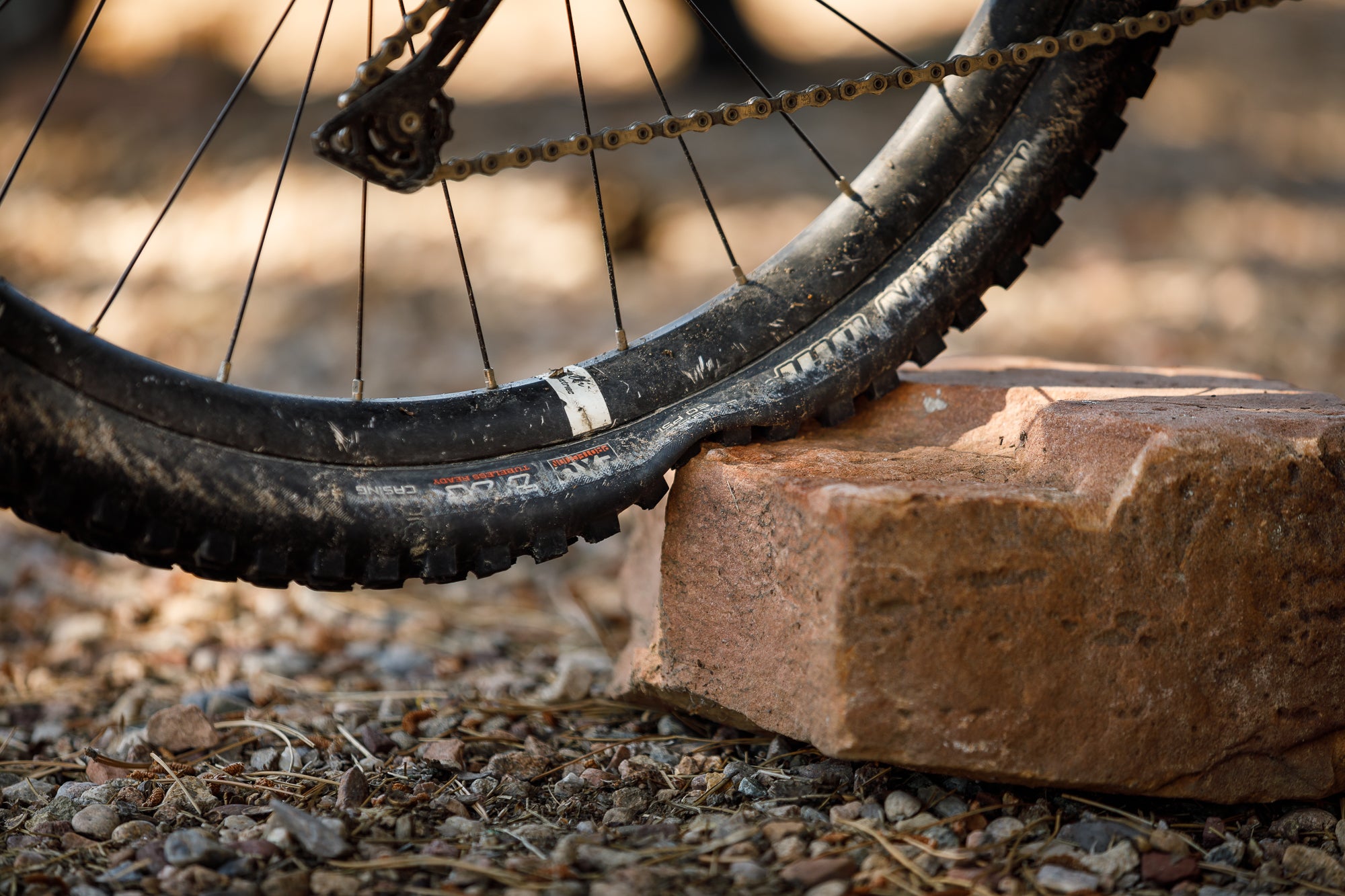 The foam insert in this tire prevents it from hitting the rim when impacting a square-edged rock.
The foam insert in this tire prevents it from hitting the rim when impacting a square-edged rock.Like protective pads you wear on your body, a foam tire insert acts as a physical barrier to prevent the tire from bottoming out against the rim. It absorbs the energy from impacts so, hopefully, your wheels and tires can roll away unscathed. Because inserts take up air volume in the tire, they also provide some other benefits, such as increased sidewall support and tire damping, which will be explained further below.
The pros and cons of tire inserts
Pros
- Allows lower tire pressures
- Damped feel
- Sidewall support
- Rim protection
- Burp prevention
Currently, one of the most popular insert options on the market is the CushCore Pro because it was one of the first inserts available and it provides the highest level of protection. I use these myself, and so do many riders I meet at enduro and downhill events. CushCore claims its insert reduces impact forces by 50 percent.
Because enduro and downhill riders often exceed the limits of their wheels and tires, tire inserts can give them the confidence to ride aggressively without worrying about flats or rim damage. Many riders will only need an insert in the rear since the rear wheel supports the majority of the rider’s weight and is more susceptible to damage. However, larger riders or those who really shred may prefer inserts on the front and rear.
 Examples of impact damage sustained by a CushCore Pro tire insert. The divots in the foam show impacts that likely would have resulted in a cut tire or damaged rim without the insert.
Examples of impact damage sustained by a CushCore Pro tire insert. The divots in the foam show impacts that likely would have resulted in a cut tire or damaged rim without the insert.In the past, riders have often turned to thicker tire casings, heavy-duty alloy rims, and higher tire pressure to protect their wheels and tires. Tire inserts, however, can allow riders to run lighter tires and rims because of the added protection. This can often offset the added weight of an insert by creating a lighter overall wheel and tire set-up with the same or better durability.
Some riders like using inserts to protect expensive, lightweight carbon rims, even if they aren't riding aggressively. Inserts can open up the option of lightweight carbon wheels to riders who might have been hesitant about riding them before.
Inserts also provide benefits beyond rim and tire protection. CushCore claims its insert provides a 12 percent smoother ride, 35 percent more sidewall stability, and improved suspension performance and reduced rolling resistance. Much of this comes from the fact that inserts allow riders to run lower tire pressures, improving traction and comfort.
Low tire pressures may cause unwanted sidewall flex in the tire during hard cornering. At worst, a soft tire could burp air when the tire bead momentarily separates from the rim. Inserts like CushCore Pro, however, press up against the inside of the tire, providing sidewall support during cornering and locking in the tire bead to prevent burps. This combination of low tire pressure, traction, and sidewall stability can allow riders to corner much more aggressively.
An additional benefit of inserts is the noticeably damped feel the foam provides over rocks, roots, and trail chatter. Inflated tires essentially act like an undamped spring, so adding an insert to dissipate force improves how they respond to impacts. By smoothing out and quieting impacts and chatter, they can reduce rider fatigue, increase control, and conserve momentum through rough terrain. Some riders note that the damped feel of tire inserts can actually reduce arm pump and hand fatigue on long descents.
Cons
- Added rotational weight
- Potentially difficult installation and removal
- Can interfere with flat repair
- Cost
- Not 100-percent effective
The two main issues for riders hesitant about adding inserts to their bike are added weight and the installation and removal process. Any foam insert is going to weigh more than an equivalent amount of air. CushCore inserts add over half a pound to a wheel and tire. The weight is placed in the worst place possible, at the very outside of the wheel. This added rotational weight will hamper pedaling and acceleration, and it can take away the snappy feel of a light and nimble bike.
Riders concerned with weight can ride without an insert, as long as they take good lines and avoid impacts that might overwhelm their wheels and tires. That being said, many high-level XC racers are beginning to experiment with more minimalist tire inserts. Vittoria's Air-Liner is around 100 grams lighter than CushCore Pro, and brands like Pepi’s Tire Noodle and Tubolight provide sub-100 gram insert options that have seen use in World Cup XC races. Flat tires can cost XC racers valuable positions and time. Any rider who is competitive and pushing the limits of their equipment can benefit from additional protection.
The second concern that scares riders off is installation and removal. Inserts like CushCore are notoriously difficult to install for first-time users. Through experience and practice, however, most novice bike mechanics should be able to learn the tricks and techniques to install an insert efficiently. I’ve gotten to the point where a CushCore only adds around 10 minutes to a tire installation or removal. Other inserts like Vittoria Air-Liner, Rimpact, and Huck Norris don't hug the rim as tightly, are much easier to install, and comparable to installing a tube.
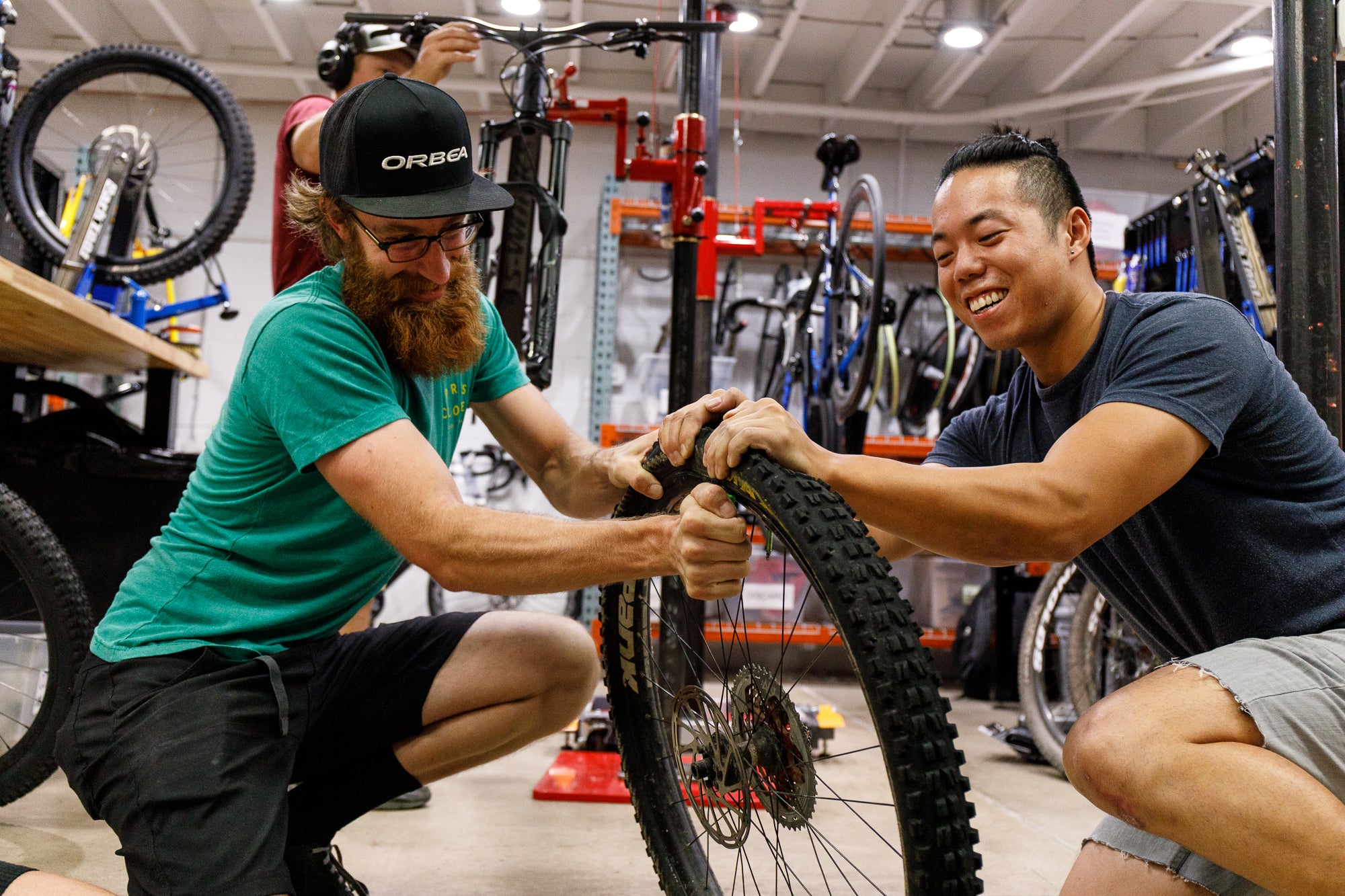 There was a steep learning curve when installing and removing CushCore for the first time. Several riders in the shop can now do it in less than 10 minutes. Other tire insert options are easier to install but may provide less protection.
There was a steep learning curve when installing and removing CushCore for the first time. Several riders in the shop can now do it in less than 10 minutes. Other tire insert options are easier to install but may provide less protection.Some skeptics complain that tire inserts are unnecessarily expensive (many sell for $100 or more) for being something as simple as a foam tube. Of course, it’s going to be cheaper to just inflate your tires with air. It’s ultimately up to you to determine if the price is worth it.
Though inserts can protect the rim and tire, they aren’t 100-percent effective. A heavier-duty insert like a CushCore will be more robust than a sub-100 gram option, but it’s not infallible. It is always still possible to cause damage if an impact has enough force to overcome the insert. Inserts also don’t protect from punctures and cuts that are caused by sharp objects in the trail. It’s possible to flat on a pointy rock and never come close to bottoming out the tire.
Of course, if you flat out in the wild with an insert, it adds more complication to the repair process. If a tire can’t be repaired with tire plugs, the insert will generally have to be removed to insert a tube. Some riders will leave an insert in the tire, use a tube with a long valve stem, and pierce the insert with the valve. Others will simply ride out on the insert with their tire deflated.
What riders at TPC think
The Pro's Closet is full of riders who obsess over their bikes and have access to a huge selection of high-end pre-owned products. Several have experimented with using tire inserts on their own bikes and had good results. Here’s what they have to say.
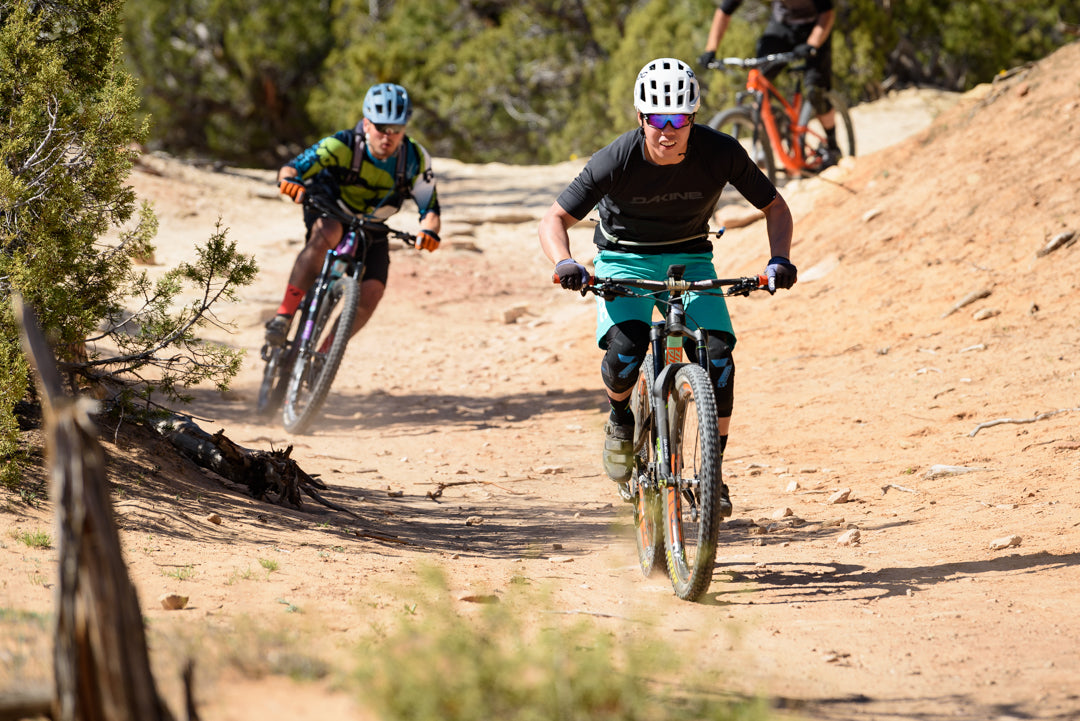 Many of our riders use inserts because our local terrain in Colorado is extremely rocky.
Many of our riders use inserts because our local terrain in Colorado is extremely rocky.Spencer P., Content Marketing Manager - Vittoria Air-Liner (rear)
“Overall, I liked Vittoria’s Air-Liner, and I plan to continue using it. It’s pretty easy to install, which is what intimidated me about inserts at first. It smoothes out rock gardens and keeps me from bottoming out my tire. But I did still crack a carbon rim with it while pre-riding the Grand Junction Off-Road course, which is very rocky. To be fair that is about as extreme as it gets for a cross-country course. So there is a limit to what it can do for you. I wouldn’t say I noticed the weight that much, but maybe I’m not fast enough to notice.”
Steve G., Shipping Manager - CushCore Pro (front & rear)
“CushCores provide an excellent Band-Aid solution for the issues of tire punctures and rim damage. The combination of CushCore and DH tires increased my confidence almost instantly. I can run slightly lower pressures and jump blindly into rock gardens without hesitation. I didn't realize how much I was holding back due to the underlying fear of punctures and blowing up rims. I run CushCore front and rear on my enduro bike, and rear-only on my aggressive hardtail. I do notice the rotational weight added to the wheels. While I don't consider it to be the best solution to MTB wheel/tire issues, I will continue to run them until a better product is available.”
Myles O., Bike Technician - CushCore Pro (front & rear)
“Running CushCores front and rear and I often forget they are there. For years I have destroyed tires long before their life deserved to be ended. With inserts, I no longer have to worry about a pinch flat ruining a race or a ride and can take full advantage of the grip the tires have to offer since I no longer have to run ultra-high pressures. Definitely the best thing since sliced bread.”
Steve W., Continuous Improvement Coordinator - CushCore Pro (rear)
“Cushcore gives me the confidence to plow through chunky sections and smash my rear wheel into anything. My dented rim might argue that it gives me to much confidence though.”
Bruce L., Technical Writer - CushCore Pro (front & rear) / Rimpact #SendNoodz (rear)
“I broke three rear rims last year and cut so many brand new tires — I was going crazy. CushCores have changed how I ride. I can just plow through everything on the trail with no fear. I have still managed to flat a couple of tires with CushCores. Sometimes you just hit stuff that wrong. I had to ride out on the core and that wasn't the best. But those instances were with Maxxis EXO casing tires. I have yet to flat a heavier DoubleDown or DH casing with CushCore. I’m getting way faster at removing and installing them now too. I run a Rimpact insert on the rear of my XC/trail bike. It’s much lighter, but it’s starting to deteriorate after a bunch of bad impacts. It’s done its job though. I think I do notice the added weight on both bikes. Sometimes I feel like the added grip from the lower pressures cancels that out though.”
Do You Need Tire Inserts?
Run an insert if:
- You ride aggressively enough to puncture tires or damage rims often.
- You prefer low tire pressure but run higher tire pressure to protect your tires or rims.
- You want additional damping from trail chatter to reduce fatigue and arm pump.
- Your local terrain has a lot of sharp or square-edge rocks that can damage tires and rims.
- You’re racing competitively and need to ensure you can keep riding to the finish.
- You want extra insurance to protect expensive carbon rims.
- You like cool new tech and inserts are something you want to try.
Inserts aren’t for everyone. Some riders don't want the added weight. Others rarely have issues with wheel or tire damage, possibly because they live in regions with smooth trails or flat terrain that rarely gives them a chance to smash rocks at high speed. And of course, there will be riders who don’t want to deal with the additional work of setting up tires with inserts.
But for those who want to prevent damage to their wheels and tires, who want the added damping benefits, or who want maximum durability for racing or everyday riding, tire inserts are one of the best options currently available.
Do you run tire inserts in your MTB? Are you on the fence? What is your opinion, and which insert is your favorite? Let us know in the comments!

